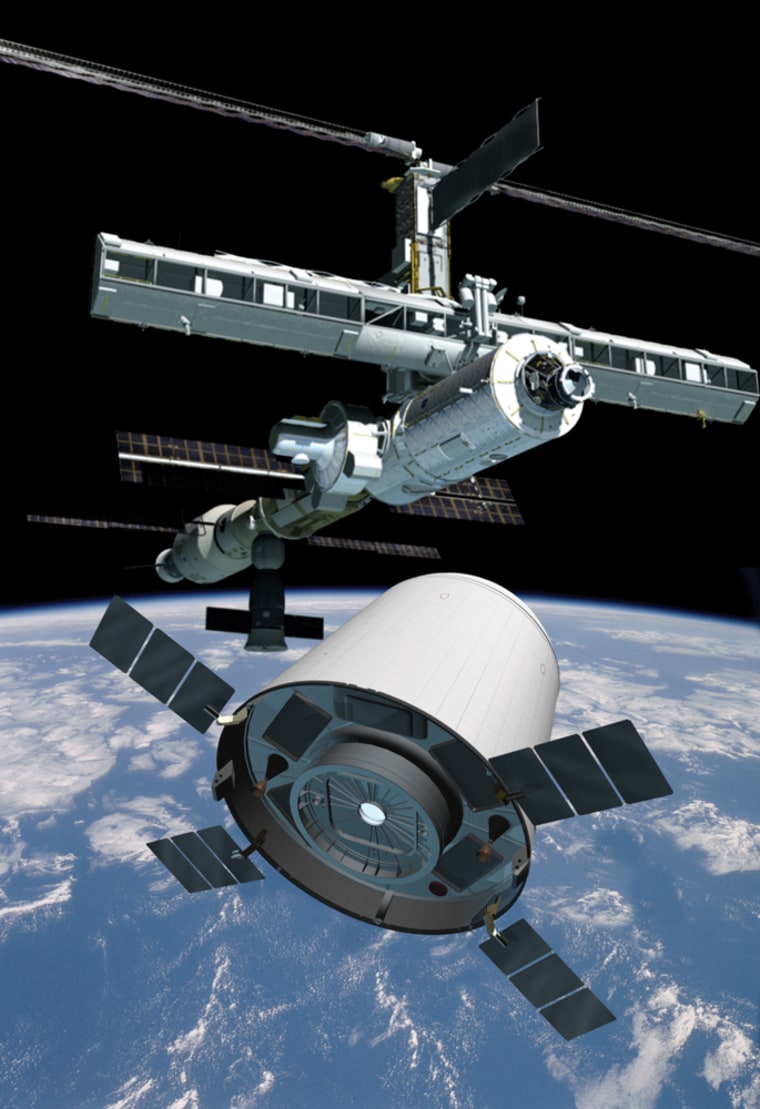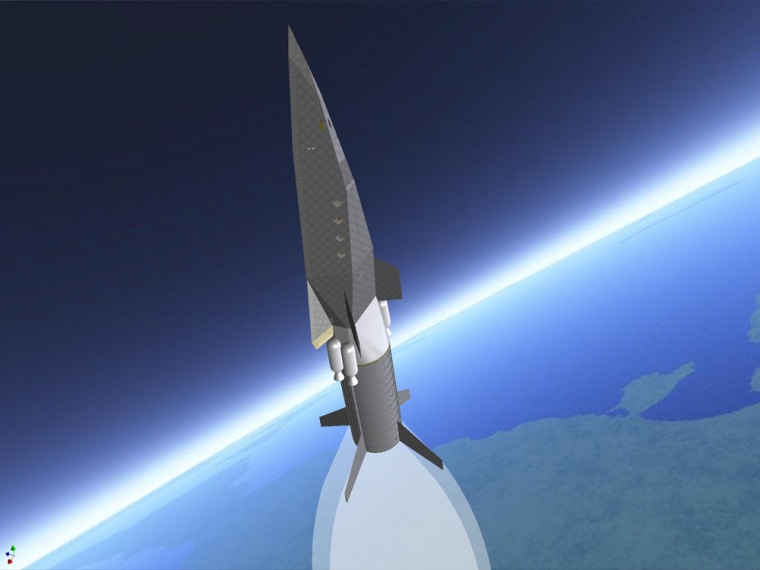Two of the also-rans in NASA's $500 million competition for spaceship concepts won a consolation prize Thursday: the space agency's promise to advise them as they continue to develop their concepts with private funding.
Chicago-based PlanetSpace and Virginia-based Transformational Space Corp. would receive no NASA funding under the newly announced agreements, but they would be entitled to the agency's feedback — an arrangement that could help keep them in the running for contracts to resupply the international space station after the space shuttles are retired in 2010.
Two other competitors for those contracts — California-based SpaceX and Oklahoma-based Rocketplane Kistler — are receiving more substantial support from NASA, in the form of the $500 million awarded last year under the terms of the Commercial Orbital Transportation Services program, or COTS. PlanetSpace and t/Space were among the companies passed over during that competition.
In a written statement, Scott Horowitz, NASA's associate administrator for exploration systems, said the agency was "proud to reach agreements with two more private companies dedicating their own resources toward establishment of a robust commercial launch industry."
NASA said the Space Act Agreements establish milestones and criteria by which the companies can gauge their own progress over the next couple of years, as they develop spacecraft capable of bringing cargo and even crew members to the space station. The agency pledged to share information that would help the companies understand the requirements for such resupply services. It would also acknowledge the companies' achievement of the milestones along the way, leading up to orbital demonstration flights by 2010.
New competition in 2010
In the 2010 time frame, NASA would reopen the COTS competition, which is part of the Commercial Crew and Cargo Program, and award what could be billions of dollars in contracts for space station resupply. Such services would help bridge the gap between the shuttle fleet's retirement and the scheduled debut of the shuttle's successor in 2014.
NASA is spending billions of dollars on that successor, the Orion crew exploration vehicle, which is being developed by a team led by Lockheed Martin. The Orion would be capable of trips to the moon as well as the space station — and even after it enters service, NASA might prefer to use the lower-cost services that could be offered by SpaceX, Rocketplane Kistler, PlanetSpace, t/Space and perhaps other companies.
"By stimulating the growth of commercial space enterprise, NASA will free itself to focus on long-range exploration of the moon and Mars," Horowitz explained.
Alan Lindenmoyer, manager of the Commercial Crew and Cargo Program Office, saluted the willingness of PlanetSpace and t/Space to continue with their development efforts even though they wouldn't be receiving NASA funding.
"The importance of these agreements is that they demonstrate the willingness of entrepreneurs to invest their own resources with NASA's commitment to help develop a whole new sector of the commercial space industry," he said in NASA's statement.
T/Space: ‘We will be a known quantity’
Having the agreements with NASA, plus the prospect for contracts to come, presumably would make it easier for the two companies to attract private investors.

"As we raise investor funds and go forward, we will be known to NASA, and we will be a known quantity when we show up knocking on their doors ready to deliver cargo," t/Space President David Gump told MSNBC.com.
T/Space already has conducted the initial phases of testing for its Crew Transfer Vehicle, or CXV, an air-launched, piloted craft that is based on the 1960s-era design for the return capsules from U.S. Corona satellites.
Unmanned prototypes of the CXV were built under the terms of an earlier $6 million NASA contract, and in 2005, the company subjected the CXV to aerial drop tests to study its aerodynamics and safety.
"We think it really is much safer and much more flexible, especially if you're tring to rendezvous with something already in orbit such as the space station," Gump said. "Our air-launch concept, I think, will be the one that works. ... We will have prices significantly below SpaceX and Rocketplane Kistler."
T/Space said its development effort would culminate with a crewed flight to orbit in late 2010.
PlanetSpace: Excited to work with NASA
PlanetSpace was formed with the financial backing of Indian-American entrepreneur Chirinjeev Kathuria, who made his fortune in the telecommunications industry and was also involved in the ill-fated effort to commercialize Russia's Mir space station. Kathuria's partner in the venture is Geoff Sheerin, leader of the Canadian Arrow rocket team.
PlanetSpace already has secured an agreement for an orbital launch facility in Nova Scotia, and is closing in on a deal for a production facility and suborbital spaceport in Ohio. It intends to build boosters based on Russia's Soyuz rocket design, with updated V-2 engines. The Nova booster could loft a hypersonic glider known as the Silver Dart into suborbital or orbital flight. The company is finishing up its spacecraft design, wind tunnel testing and engine development, but has not yet conducted test flights, Sheerin told MSNBC.com.
Kathuria said he was excited about working with NASA under the new agreement, which took months to negotiate. "PlanetSpace anticipates investing significant private capital toward its activities and completing our first demonstration flight by December 2009," Kathuria said.
Sheerin said PlanetSpace has forged a separate agreement with NASA's Marshall Space Flight Center under which the company would receive technical support in the areas of propellant tank design, structural engineering and flight operations. Kathuria said NASA would be compensated for that assistance.
Sheerin said NASA's timetable for the development effort sets out quarterly milestones leading up to the orbital flights in the 2009-2010 time frame. He said the major milestones include a glide test of the Silver Dart, scheduled for the second quarter of 2008; and suborbital flights by the end of 2008.
The suborbital flights would mesh with PlanetSpace's plans to offer passenger space tours. However, PlanetSpace would have to win regulatory approval from the Federal Aviation Administration for such launches.
